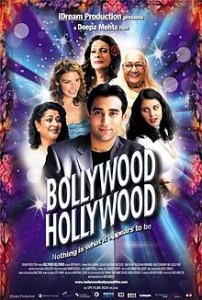 As many of our readers may already know, April 26th is celebrated as World IP Day, a day first marked 14 years ago by WIPO ‘in order to promote discussion of the role of intellectual property (IP) in encouraging innovation and creativity.’ In celebration of a 100 years of cinema this year, WIPO has themed this World IP Day around “Movies: A Global Passion”. I should admit that I’m unsure of how 2014 brings a 100 years of cinema, as, in India at least, Dadasaheb Phalke’s “Raja Harishchandra” was made in 1913, making it now a 101 years of cinema in India!
As many of our readers may already know, April 26th is celebrated as World IP Day, a day first marked 14 years ago by WIPO ‘in order to promote discussion of the role of intellectual property (IP) in encouraging innovation and creativity.’ In celebration of a 100 years of cinema this year, WIPO has themed this World IP Day around “Movies: A Global Passion”. I should admit that I’m unsure of how 2014 brings a 100 years of cinema, as, in India at least, Dadasaheb Phalke’s “Raja Harishchandra” was made in 1913, making it now a 101 years of cinema in India!
Nevertheless, I find this a terrific theme, if for nothing other than the opportunity to discuss a plethora of movie related IP issues that have crossed my mind at some point or the other. Though I will be jumping across several issues in this blogpost – mostly in the form of questions – there is a thread of commonality that ties them all together and that is captured by the following line from Francis Gurry’s World IP Day message, “How can we take advantage of this extraordinary opportunity to democratize culture and to make creative works available at the click of a mouse, while, at the same time, ensuring that the creators can keep on creating, earning their living, and making the films that so enrich our lives?”
In the first part, I look at the effect that IP policy has with respect to the movie industry. In the second part, I flip this coin and look at the effect that movies have on IP. [Warning: long post ahead!!]
1. What’s the relation between IP and a successful movie industry?
Firstly, how exactly does one determine what is a successful movie industry? Do you look at the amount of movies made? Or the amount that movies make? Or perhaps if cultural dissemination is indeed a goal, then by the diversity of those who make movies? According to Wikipedia, India’s film industry (i.e., not just bollywood) produces the most number of films per year(as well as ticket sales) with an astounding ~3000 films on celluloid of which about ~1200 were released as feature films. I don’t know if there’s a study on this but the Indian film industry also is certainly one of the most, if not the most diverse in the world, given the cultural composition of India coupled with the fact that several regions within India have their own language specific industries.
While cinema has been an integral part of Indian culture much prior to the widespread penetration of digital technology, Nigeria’s film industry saw a huge boost in it’s movie producing capacity with the influx of affordable digital technology. It is currently the 2nd largest producers of movies, just behind India.
 Coming a distant third is US’ film industry with just over 500 films annually. However, Hollywood attracts far more revenues than any other film industry, at about $10,900 million – about 3 times more than the 2nd placed film industry (China’s) and about 10 times more than India’s film industry. Interestingly, ‘the big 6’ Hollywood studios receive about 90% of these revenues.
Coming a distant third is US’ film industry with just over 500 films annually. However, Hollywood attracts far more revenues than any other film industry, at about $10,900 million – about 3 times more than the 2nd placed film industry (China’s) and about 10 times more than India’s film industry. Interestingly, ‘the big 6’ Hollywood studios receive about 90% of these revenues.
There are of course several factors and several nuances to examine when discussing this but I do wonder how copyright policies, with their ever increasing terms and generally maximalist tending policies are affecting movie productions and creation of new cultural material in this age where it is becoming increasingly easier to actually create, as has been seen in the much poorer markets of India and Nigeria. It appears that ‘the big 6’ studios are also increasingly engaged in less ‘creation’ and primarily more engaged in distribution, marketing and financing of films produced by ‘independent’ or smaller movie studios. It’s also worth mentioning that these hollywood lobbies have had much influence in introducing several controversial maximalist IP policies, right from the TRIPS Agreement, to the now infamous SOPA/PIPA.
What kind of policies incentivize more creation in the film industry? Not to say it is even close to perfect but one cannot deny that for all the criticism it receives, the Indian IP regime (or whatever it is that is incentivizing movie creation in India) seems to be working pretty decently. It makes one wonder if perhaps the incentive to create comes from outside of the IP regime as well – this might as well be a radical thought in IP debates today! And/or, as Dr Arul Scaria has pointed out, that India’s piracy problem may be not quite what it’s made out to be. (On a related note, though I haven’t read it yet, his new book titled “Piracy in the Indian Film Industry: Copyright and Cultural Consonance” seems like it would be very relevant to this discussion)
There also seems to be little discussion on the value of this ‘democratization of culture’ that is permitted by the presence of such variety – and how copyright affects this. Such a conversation would be enriched if this variety of risk takers and content creators are contrasted with the situation in Hollywood, where the top 6 studies pretty much decide what content is worth investing and backing, and where few, if any, have the resources to go head to head against these big 6 in terms of financing, advertising, finding premium movie release dates, etc. This is especially worrisome if one takes into account that, perhaps due to the their ability to market or perhaps due to other factors, Hollywood definitely affects some kind of ‘cultural imperialism’ across its ~3 billion odd audience. I would think that a large part of this ‘oligarchy’ has been created by allowing big studios to capture more than the value they are putting into the market, by means of unnecessarily restrictive copyright policies. This brings me back to my original question, still unanswered, what exactly is the relationship between IP and a successful movie industry? One thing is clear and that is that the current dominant discourse of simply expanding copyright and implementing more strict enforcement mechanisms is hardly an answer to this question. Instead, it may be more fruitful in exploring business models that allow better dissemination of content that people are willing to pay for, methods of payment that are simple and transparent, and perhaps more recognition of the increasing fluidity of content consumers and content creators that technology is allowing – amongst several other factors.
2. How do movies treat IPRs?
Taking a completely different turn from the above debate, let’s now look at the other side of the IP and cinema coin – how cinema treats IP. Cinema often performs a dual and often intertwined role to society – providing a reflection of society, as well as providing images that can mould society.
Intellectual property rights are a collection of concepts that, till very recently, had not quite found themselves any space in the public discourse, or in popular narratives. However, given the increasingly crucial role it plays in structuring our technological growth and societal progress, it has started creating more space for itself in modern day cinema. Notably, methods of cultural dissemination such as cinema provide a very interesting ‘counter’ to the problem posited by the ‘Public Choice Theory’ – which effectively states that a small collective of similar corporations that have high rents to gain from a specific policy will have more of an influence on such policy, than a larger collective of independent individuals who will suffer small individual losses due to that policy, even if the aggregate loss is greater than the aggregate gain, as there is insufficient incentive for any individual suffering such loss to bring together a collective of such individuals and then build a sufficient lobby against such policy. Cinema, by building a narrative around it, allows the visualisation of that aggregate effect on society. And this narrative, or this visualization can provide the public imagination the drive to aggregate the public opinion around these issues.
This can happen on two levels:
 Firstly, by introducing an alien concept into public discourse. While most people have heard of ‘patents’, ‘copyrights’ and ‘trademarks’, it’s still uncommon for the lay person to know much more besides that these legal concepts can be used to protect products or maybe ideas. So, in this case, merely introducing these concepts are a big step in starting a larger understanding of what these are and how they may affect one. Shouvik wrote a terrific two part piece on ‘IP in Cinema’ wherein he listed a number of movies which dealt with, in at least some amount of detail, the introduction of one or more of these IP concepts to the audience. (See his posts here: Part 1 and Part 2). For example, “Flash of Genius“, with an inventor protagonist centered around a patent law suit against the big 3 in the automative industry. Similarly, the plot of “The Last Station“, Leo Tolstoy’s biopic plays a lot of importance on the ownership of copyrighted material and works in the public domain.
Firstly, by introducing an alien concept into public discourse. While most people have heard of ‘patents’, ‘copyrights’ and ‘trademarks’, it’s still uncommon for the lay person to know much more besides that these legal concepts can be used to protect products or maybe ideas. So, in this case, merely introducing these concepts are a big step in starting a larger understanding of what these are and how they may affect one. Shouvik wrote a terrific two part piece on ‘IP in Cinema’ wherein he listed a number of movies which dealt with, in at least some amount of detail, the introduction of one or more of these IP concepts to the audience. (See his posts here: Part 1 and Part 2). For example, “Flash of Genius“, with an inventor protagonist centered around a patent law suit against the big 3 in the automative industry. Similarly, the plot of “The Last Station“, Leo Tolstoy’s biopic plays a lot of importance on the ownership of copyrighted material and works in the public domain.
 Secondly, rather than simply introducing a topic to public discourse, cinema also has the power to create public discourse around a topic. On the topic of IP, there are a few clear examples where this has happened. (Spoilers may be present): Most recently, “Fire in the Blood” has been creating waves all around the world. Centered around the millions of deaths caused by the AIDS crisis and the role that Big Pharma and forced patent monopolies played on creating that crisis, the film is a powerful and emotional watch. As the name suggests, the film has been made to create rage at the injustice, and not merely generate sympathy or sadness at the plight of others. Tellingly, the film ends with a call to action, asking the audience to ensure that the film does not require a sequel. Similarly, Lorenzo’s Oil, based on a true story, powerfully describes the the plight of a child with ALD, a rare disease, that doesn’t receive any funding from the pharma industry as R&D incentives aren’t geared towards encouraging treatments which can’t bring in profits. It goes on to show how his parents do everything possible to discover and concoct a treatment for their child – The sheer will power of the parents to find a treatment results in these (non-scientist) parents managing to finally do what scientists and labs around the world told them they could not do. I’d be very surprised if anyone who watches either of these movies aren’t deeply moved by them – and hence their ability to create discourse. I can testify that when I screened this movie for my class at Nalsar, students continued talking about it for days.
Secondly, rather than simply introducing a topic to public discourse, cinema also has the power to create public discourse around a topic. On the topic of IP, there are a few clear examples where this has happened. (Spoilers may be present): Most recently, “Fire in the Blood” has been creating waves all around the world. Centered around the millions of deaths caused by the AIDS crisis and the role that Big Pharma and forced patent monopolies played on creating that crisis, the film is a powerful and emotional watch. As the name suggests, the film has been made to create rage at the injustice, and not merely generate sympathy or sadness at the plight of others. Tellingly, the film ends with a call to action, asking the audience to ensure that the film does not require a sequel. Similarly, Lorenzo’s Oil, based on a true story, powerfully describes the the plight of a child with ALD, a rare disease, that doesn’t receive any funding from the pharma industry as R&D incentives aren’t geared towards encouraging treatments which can’t bring in profits. It goes on to show how his parents do everything possible to discover and concoct a treatment for their child – The sheer will power of the parents to find a treatment results in these (non-scientist) parents managing to finally do what scientists and labs around the world told them they could not do. I’d be very surprised if anyone who watches either of these movies aren’t deeply moved by them – and hence their ability to create discourse. I can testify that when I screened this movie for my class at Nalsar, students continued talking about it for days.
So, whether we’re looking at the effect of IP on movies, or movies on IP, there certainly are several interesting angles to consider, and as we progress into a time where IP is increasingly intertwined into our lives, these perspectives can only get more nuanced. So, let’s hope all the relevant actors, IP or movie, can successfully capture these nuances! And with that, I’ll end this rather long post and thank the readers who’ve made it this far! Wishing a happy world IP day to all our readers!
